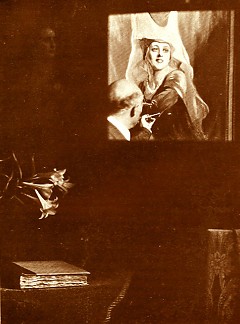|
12. The Value of a
Mirror

The chief value of the hand mirror is that
it gives a new point of view of both
sitter and portrait. It acts as a check on drawing
and the relation of tones.
Q: Does that little mirror you keep looking
into help you to decide what you are going to
do?
"Yes, to some extent it does. But its chief
value is that it gives me a new view of both picture
and sitter and therefore enables me to discover
any faults there may be in drawing, or in the
relations of tones. It acts like the fresh eye
which can often perceive defects that the painter,
having got accustomed to them, has failed to detect.
I take a look in the mirror from time to time
as a sort of self-criticism. At any rate the mirror
is an honest critic."
Q: Is it useful as a means of studying your
sitter's expression?
"No, not particularly. But sometimes a mirror
can be used in such a way that it helps to give
the sitter the expression I want. When, for instance,
he is getting tired or restless, or even, in some
cases, when he is shy and I cannot, by talking,
arouse in him the vivacity that he must have to
make his portrait reasonably successful, I place
a mirror in his line of vision so that he can
watch in it the progress of the picture as I
| |

The standing mirror entertains
the sitter and helps to maintain
the desired expression. |
work. I like my sitters to see what I am doing
to the portrait at every stage and I am sure that
by letting them look on in this manner I not only
induce in them the interested expression at which
I aim, but also offer to some of them, who have,
hitherto, not had an opportunity to see a picture
in the making, an educational experience which
they enjoy."
Oh, yes, people always do enjoy being taken behind
the scenes and shown how things are worked.
13. Keeping the Sitter's
Interest
"Then why not encourage them? I have often
noticed that a sitter's interest in painting and
even in art in general grows while he is in the
studio and I do believe that as a result of his
experience there he will always in the future
approach art with much more interest than before."
Q: The only objection that occurs to me is
that watching you at work might have a tendency
to make him move about: don't you want him to
keep still?"
"Naturally I do, but there is a great difference
between being still and becoming set and lifeless.
If the sitter's face is lacking in animation the
risk that the portrait, no matter how hard one
tries, will be a dull record is very great and
I feel that such a risk ought to be avoided at
all costs. My way of preventing it is to do all
I can to keep his interest awake and to make him
alert and lively. Still, I do not deny that it
is difficult at times, as all people are not equally
responsive. "
Q: I suppose sitters do vary greatly in their
ways: you cannot deal with them all in the same
manner."
"Very definitely not, and what is the right
manner in which each one should be dealt with
is the first thing a portrait painter has to find
out; indeed, upon that will often depend the success
or the failure of his picture. Before he can decide
what kind of treatment he should adopt he has
to give at least as much attention to his sitter's
mental characteristics as to his physical appearance;
a portrait is not a still-life study, therefore
it must be a good deal more than a simple record
of a face. It must be a psychological revelation
as well."
|